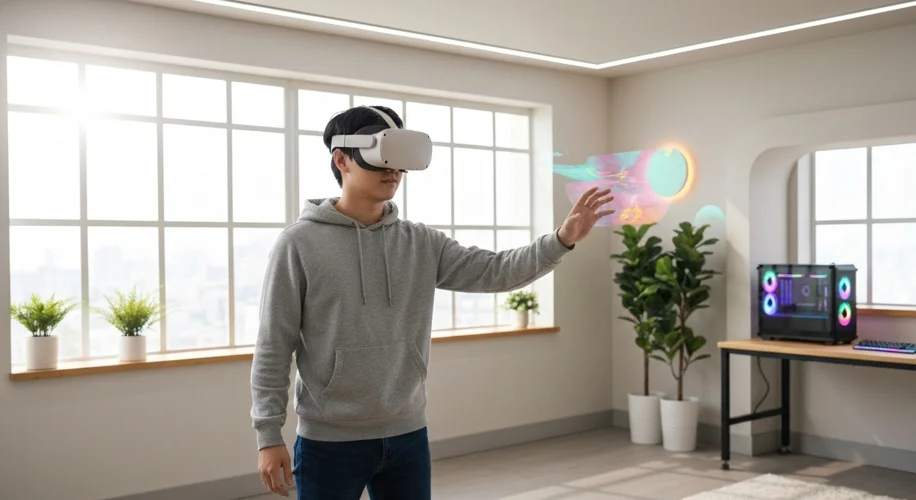Alright, so you’re thinking about diving into VR, or maybe upgrading your current setup. That’s awesome! The VR world is getting seriously good, and right now, Meta’s Quest line is a huge part of that. But which one should you grab? Let’s break down the Quest 3 and the rumored Quest 3S, and then we’ll get into how to actually hook up a PC for that ultimate VR experience.
Quest 3 vs. Quest 3S: The Lowdown
First off, the Meta Quest 3 is the current king. It’s a standalone headset, meaning you don’t need a PC to use it, but you totally can use it with one. It’s got great mixed reality capabilities thanks to its color passthrough cameras, which means you can see your real surroundings while still being in VR. This opens up a ton of cool applications beyond just gaming – think productivity or interacting with virtual elements in your actual room.
Pros of Quest 3:
* Excellent color passthrough for mixed reality.
* Sharper display and better performance than its predecessor.
* Works as a standalone headset or PCVR headset.
Cons of Quest 3:
* It’s the more premium option, price-wise.
Now, the Quest 3S is what a lot of people are talking about. While Meta hasn’t officially announced it, leaks and rumors point to a more budget-friendly version of the Quest 3. Think of it as a Quest 2 but with some of the Quest 3’s upgrades. It might lose some of the high-end features, like maybe the full-color passthrough, opting for a more basic black-and-white version, or perhaps a less powerful processor, to hit a lower price point. If it sticks close to the Quest 2’s form factor but with a Quest 3 screen or chip, it could be a killer deal.
Pros of a potential Quest 3S:
* Likely much more affordable.
* Still offers a solid VR experience, especially for gaming.
Cons of a potential Quest 3S:
* Might sacrifice some features for cost (e.g., passthrough quality).
* Performance might be dialed back compared to the full Quest 3.
Who should get what?
- Get the Quest 3 if: You want the best mixed-reality experience, the sharpest visuals, and don’t mind paying a bit more for those top-tier features. It’s great for developers, early adopters, and anyone who wants to experiment with AR/VR hybrids.
- Wait for or consider the Quest 3S if: Your main goal is affordable VR gaming and experiences, and you’re okay with fewer bells and whistles. If the price is right, it could be the perfect entry point.
Leveling Up with PCVR
This is where things get really exciting. Connecting your Quest headset to a PC unlocks a whole universe of demanding VR titles and experiences that your standalone headset can’t handle on its own. Think ultra-realistic graphics and complex simulations.
Your PC Needs:
To run PCVR smoothly, your computer needs some juice. You’re generally looking for:
* GPU (Graphics Card): This is the most important part. Something like an NVIDIA RTX 3070 or AMD RX 6800 or higher is a good starting point for solid performance. Newer cards will always give you a better experience.
* CPU (Processor): A modern multi-core processor (like an Intel Core i5 or AMD Ryzen 5 from the last few generations) will keep things running smoothly.
* RAM (Memory): 16GB is pretty much the minimum these days, and 32GB is even better if you plan on multitasking or running really demanding sims.
* USB Ports: You’ll need at least one high-speed USB 3.0 port for wired connections.
Connecting Options:
- Wired (USB-C): This is usually the simplest way to start. You’ll need a good quality USB-C cable (Meta’s Link Cable is popular, but other high-speed USB-C cables work too). It offers a stable connection with minimal latency, and your headset even charges while you play.
-
Wireless (Air Link / Virtual Desktop): This is where the magic of no wires comes in! Both Meta’s Air Link and third-party apps like Virtual Desktop (available on the Quest store) let you stream PCVR games wirelessly. For this to work well, you absolutely need a strong Wi-Fi network, ideally with your PC connected via Ethernet to your router, and your Quest headset connected to the 5GHz band of your Wi-Fi.
Other Headsets to Consider:
- PSVR2: If you’re a PlayStation owner, the PSVR2 is a fantastic option. It offers amazing visuals and haptic feedback, but it’s locked to the PlayStation ecosystem. It doesn’t connect to a PC.
- Bigscreen Beyond: This is for the true enthusiasts. It’s incredibly small and light, custom-fitted to your face, and offers incredibly high resolution. However, it requires a powerful PC and the base stations/controllers for tracking, making it a much more involved and expensive setup. It’s definitely not an entry-level device.
So, whether you’re eyeing the Quest 3 for its mixed reality prowess or waiting for a potentially more affordable Quest 3S, and whether you decide to go wired or wireless for PCVR, the options are seriously exciting. Dive in, experiment, and let me know what you discover!

